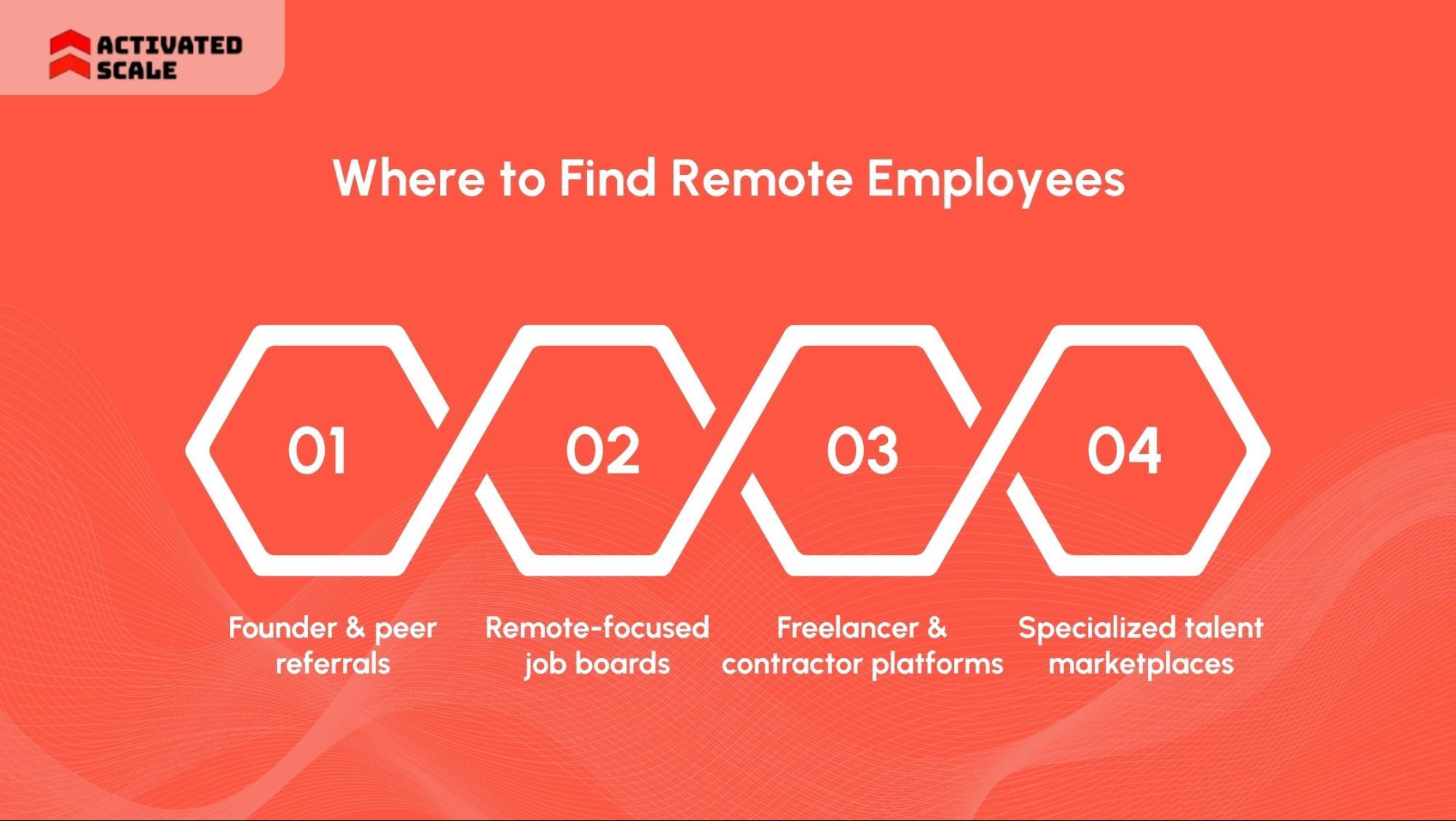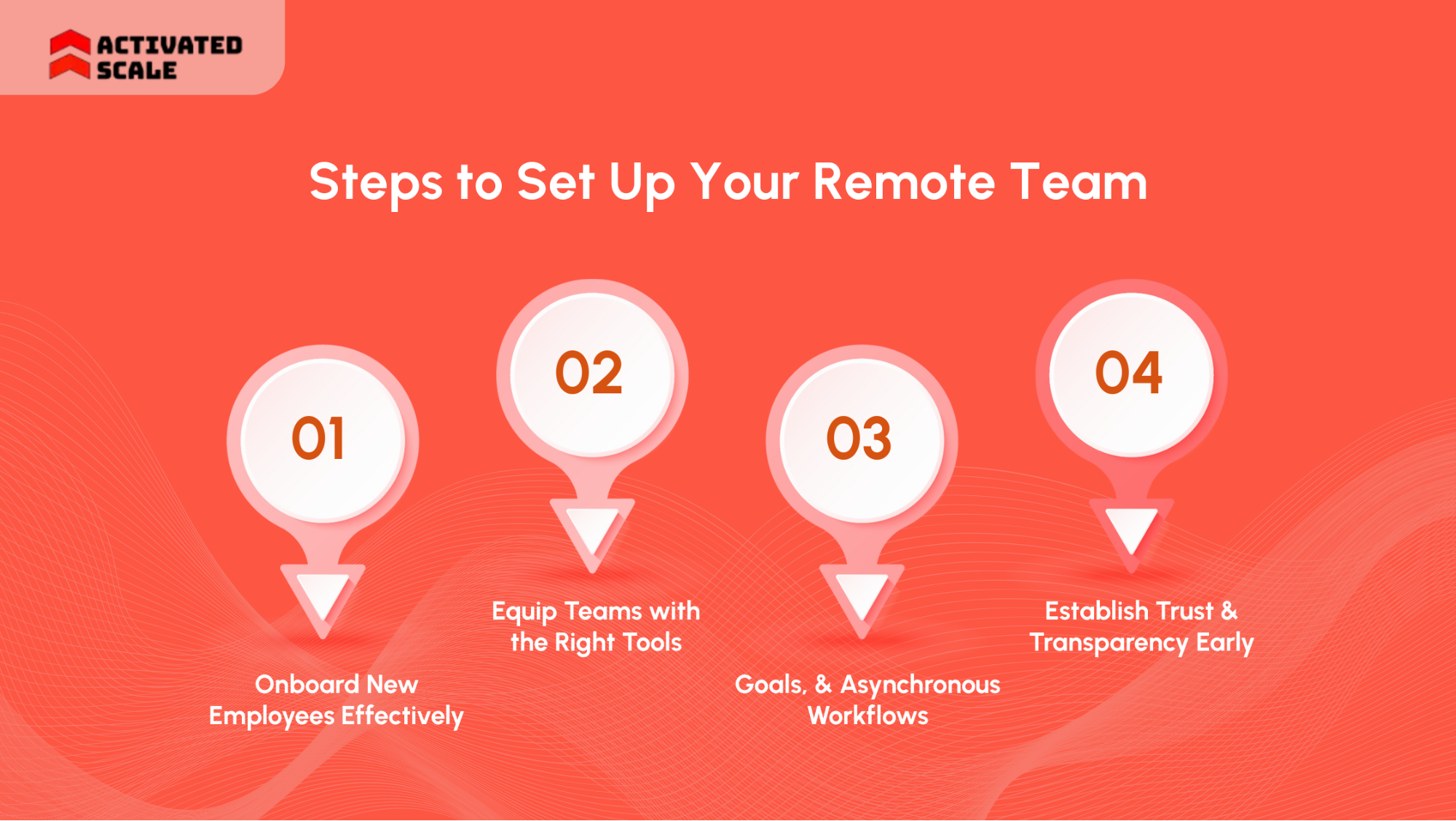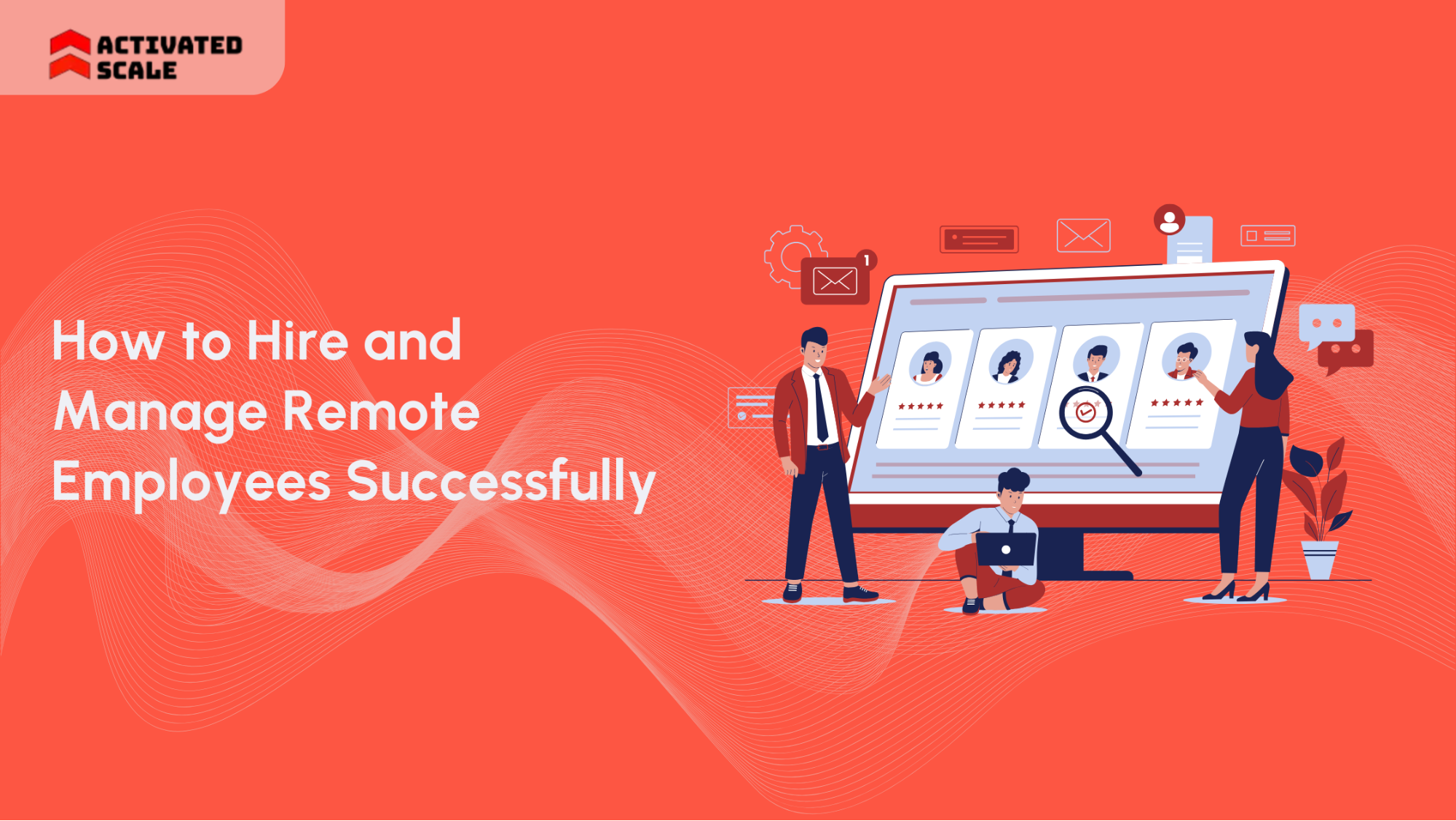The pandemic changed the way teams work, proving that productivity isn’t tied to office walls. What began as a temporary adjustment during COVID-19 has become a permanent part of how businesses grow. In 2025, 32.6 million Americans, around 22% of the workforce, were working remotely, and that number continues to rise.
For startup founders, this shift brings both opportunity and pressure. Building a remote team widens your access to talent across the country. However, it also introduces new challenges in hiring, performance management, and maintaining trust across screens.
If you’re wondering how to hire remote employees effectively, this guide will walk you through practical steps to find the right people, onboard them smoothly, and keep your team aligned from day one.
Key Takeaways
- Define clear roles, KPIs, and remote work policies before hiring to avoid misalignment.
- Hire strategically through referrals, remote job boards, and fractional options to find reliable talent faster.
- Set structured onboarding, clear goals, and consistent communication rhythms to build trust early.
- Use standardized tools and transparent processes to keep teams aligned and accountable.
- Maintain engagement with regular check-ins, recognition, and ongoing training to support long-term success.
Key Benefits of Hiring Remote Employees

Hiring remotely helps startups move faster and overcome local talent limitations, while keeping costs and team structure flexible.
- Broader talent access: Reach candidates across states and regions instead of relying on one market.
- Cost efficiency: Reduce expenses tied to office space, relocation, and high-cost-market salaries.
- Easy scalability: Add or adjust headcount based on revenue goals or funding cycles.
- Faster hiring cycles: Fill roles sooner by widening your search beyond local constraints.
- Founder flexibility: Build lean, distributed teams without heavy infrastructure or overhead.
Now, the next question is how to bring them in? Should you hire a full-time employee or get a contractor?
How to Decide Between a Remote Employee and a Contractor?
Before hiring, founders need to decide whether the role requires a full-time employee or a contractor. Each model offers different levels of flexibility, cost, and compliance responsibility, which are important factors when teams are scaling and budgets are tight.
When To Choose Each Model
- Hire employees when the role drives core revenue, needs daily coordination, or requires long-term continuity.
- Get contractors when you want flexibility, shorter commitments, or proof of performance before converting to full-time.
If you’re hiring for sales roles, many startups use Activated Scale to bring on fractional SDRs or AEs quickly without the full-time risk.
Strategies to Define Roles When Hiring Remote Employees

Before posting a remote job, set up the role to help candidates hit the ground running:
- Responsibilities & Deliverables: Break down daily and weekly tasks. For example, an SDR role could focus on “booking X qualified demos per week” rather than general prospecting.
- KPIs & Success Metrics: Tie performance to measurable outcomes like conversion rates, outreach volume, or revenue contribution.
- Working Hours & Overlap: Specify required synchronous hours for meetings while allowing asynchronous flexibility.
- Tools & Tech Requirements: List essential platforms like HubSpot, Zoom, Slack, or Notion.
- Remote Policies: Include guidelines for communication, data security, device usage, and reporting workflows.
Clear, structured roles reduce misalignment, help you attract self-driven candidates, and set them up to perform from day one.
Also Read: Why Outsourcing Sales Helps Startups and SMBs Scale Faster.
How to Evaluate and Interview Remote Employees
Evaluating remote candidates effectively combines reviewing their skills, work habits, and ability to perform independently.
- Communication & Async Skills: Check clarity in emails, written tasks, or short assessments to see how they convey ideas without constant supervision.
- Remote Work Habits: Assess discipline, time management, and familiarity with tools and workflows needed for success.
- Past Remote Experience: Look for candidates with proven track records in distributed or asynchronous teams.
Sample Interview Questions:
- “How do you manage priorities without direct supervision?”
- “Describe a time you solved a problem asynchronously.”
- “How do you communicate progress with distributed teams?”
- Include job-specific prompts. For e.g., if you’re hiring an SDR or AE, you can ask how they handle U.S. leads remotely, or manage pipeline updates asynchronously.
This approach ensures you hire remote employees who are skilled, productive, and reliable in a distributed setup. But you must also plan for the practical aspects of managing remote employees.
Also Check: Fractional CMO Scope of Work: Key Roles and Responsibilities
Considerations When Hiring Virtual Employees
When hiring virtual employees, founders need to plan for operational and logistical factors that affect productivity and team alignment.
- Time zone overlap: Ensure sufficient synchronous hours for meetings and collaboration.
- Compliance considerations: Understand local labor laws, taxes, and contractor vs. employee classification.
- Equipment and security: Provide or require necessary devices, secure connections, and data protection practices.
- Cross-functional collaboration: Consider how remote employees will work with other teams and stakeholders.
- Availability expectations: Set clear guidelines for working hours, response times, and on-call requirements.
Once you’ve accounted for operational and compliance needs, the next step is figuring out where to source the right remote talent.
Where to Find Remote Employees

Founders rely on a mix of networks, platforms, and marketplaces to source remote talent. Here are a few options you can explore:
- Founder and peer referrals: Warm introductions often bring in candidates who align quickly with a startup’s pace and expectations.
- Remote-focused job boards: Sites dedicated to distributed teams help surface full-time candidates open to global or flexible work arrangements.
- Freelancer and contractor platforms: These platforms work well for project-based work, short-term needs, or early validation before deeper hiring.
- Specialized talent marketplaces: Vertical-specific platforms give founders access to pre-vetted candidates with proven experience. For sales roles, many startups use Activated Scale because it focuses exclusively on vetted, U.S.-based SDRs, AEs, and fractional sales leaders, so you can hire revenue talent without long screening cycles.
Hiring is done, but making your remote team productive takes thoughtful setup.
Recommended: Recruitment SaaS: Strategies, Platforms, & Top Hiring Firms
Steps to Set Up Your Remote Team

Once you’ve hired the right people, the real work begins by helping them succeed without being in the same room.
Onboard New Employees Effectively
Onboarding determines how quickly a new hire becomes productive and how long they stay. For remote teams, that process can’t be left to chance.
Here’s how to structure it:
- Create a clear onboarding plan: Map out the first 30, 60, and 90 days with specific learning goals, deliverables, and milestones.
- Assign a mentor or onboarding buddy: A peer guide helps new hires understand culture, communication norms, and unwritten workflows.
- Schedule structured check-ins: Hold brief weekly syncs during the first month to answer questions and reinforce clarity.
- Centralize resources: Host documentation, process guides, and recorded training sessions in one shared workspace so new employees can revisit them anytime.
Recommended: Guide to Sales Team Structure for Outsourcing Models.
Equip Teams with the Right Tools and Technology
Technology is the backbone of every remote setup. Here’s a practical tech foundation to consider:
- Communication: Slack, Microsoft Teams, Zoom
- Collaboration: Notion, Google Workspace, Miro
- Project management: Asana, ClickUp, or Trello
- CRM and sales tools: HubSpot, Salesforce, Apollo
- Security: Single sign-on tools (Okta), password managers (1Password), VPN access
Set Clear Expectations, Goals, and Asynchronous Workflows
Remote teams perform best when everyone knows exactly what they’re responsible for and how progress is tracked.
- Use SMART goals: Every objective should be Specific, Measurable, Achievable, Relevant, and Time-bound.
- Create visibility: Shared dashboards or project trackers help employees understand priorities without constant check-ins.
- Balance synchronous and asynchronous work: Use live meetings for brainstorming, reviews, or decision-making, and async tools for routine updates.
- Document processes: Outline how tasks move through your pipeline, from assignment to delivery, so anyone can step in and pick up where another left off.
Establish Trust and Transparency Early
Trust replaces physical presence in a remote environment. Teams that rely on transparency instead of surveillance sustain better morale and results.
Here’s what works:
- Manage through outcomes, not activity: Focus on metrics and deliverables instead of time online.
- Hold weekly standups or team syncs: Keep them short and structured, review priorities, progress, and blockers.
- Share open dashboards: Visibility into progress and results builds confidence among both leaders and employees.
- Maintain feedback loops: Encourage regular one-on-ones where employees can share challenges or suggestions.
With structure and tools in place, the real test begins in maintaining team energy, accountability, and performance in a fully remote setup. Additionally, if you’re planning to grow your sales function within a remote setup, this is where Activated Scale becomes a valuable partner.
How Activated Scale Fits into Your Remote Hiring Playbook
When you’re building or expanding a remote sales team, finding the right talent can quickly turn into weeks of sourcing, screening, and interview time most startups can’t spare. Activated Scale streamlines that process by connecting you with pre-vetted, U.S.-based SDRs, AEs, and sales leaders who can start contributing from day one.
You can choose fractional support, a contract-to-hire model, or a full-time addition through a marketplace built for startups selling to U.S. buyers. This flexibility helps early and growth-stage companies:
- Reduce hiring risk through trial-based engagement before full-time commitment.
- Speed up ramp-up time with sales reps who already understand startup selling environments.
- Scale up or down as revenue targets or funding cycles evolve.
Connect with us to know how you can build a reliable sales engine without the overhead of traditional recruiting.
Conclusion
Building a successful remote team needs structure, communication, and trust that carries across distance. When those foundations are in place, teams stay aligned and momentum doesn’t fade, even as the business grows.
For founders ready to strengthen their sales function, Activated Scale makes hiring easier. You can connect with pre-vetted, U.S.-based SDRs, AEs, and sales leaders on flexible terms, helping your company scale faster without the long search or upfront hiring risk.
Build your remote sales team with confidence. Talk with our team to find talent that grows with you.
FAQs
1. What’s the most important first step when hiring remote employees?
Start with clarity. Define the exact role, responsibilities, KPIs, and communication expectations before posting the job. This helps you attract candidates who are aligned with your needs and ready to perform remotely.
2. How can startups evaluate if someone is ready for remote work?
Look for signs of accountability, time management, and communication discipline. Ask behavioral questions about how candidates handle deadlines or collaborate asynchronously.
3. What tools are essential for managing remote teams effectively?
Use tools across key categories, Slack or Teams for communication, Asana or ClickUp for project management, HubSpot or Salesforce for CRM, and Google Workspace or Notion for documentation.
4. How can founders keep remote employees engaged long-term?
Recognize achievements publicly, encourage peer appreciation, and schedule regular learning sessions or virtual team activities to maintain connection and motivation.
5. How does Activated Scale support remote sales hiring?
Activated Scale connects startups with pre-vetted, U.S.-based SDRs, AEs, and sales leaders available on fractional or contract-to-hire terms, helping you build a reliable remote sales team faster and with less risk.
The Ultimate Guide to Hiring a Salesperson!
Get the step-by-step guide to hiring, onboarding, and ensuring success!
_edi.png)




